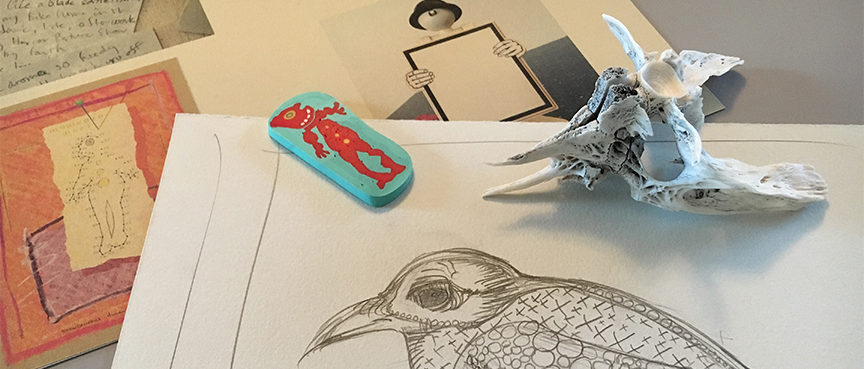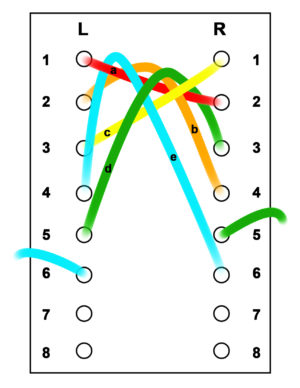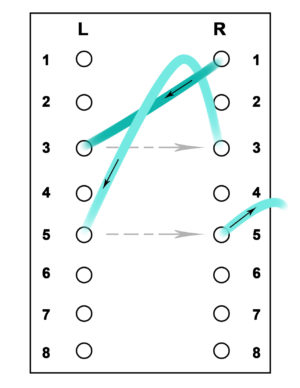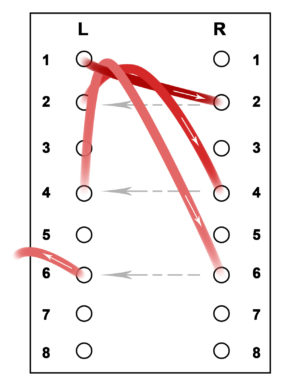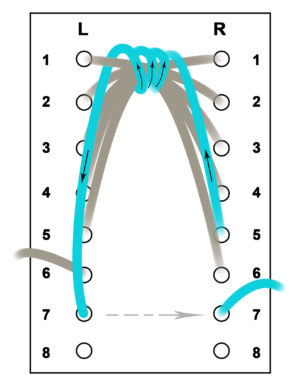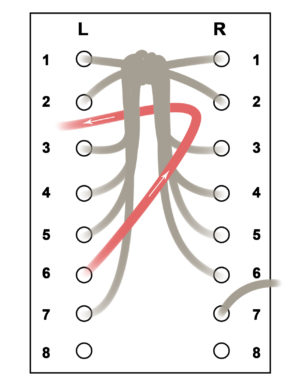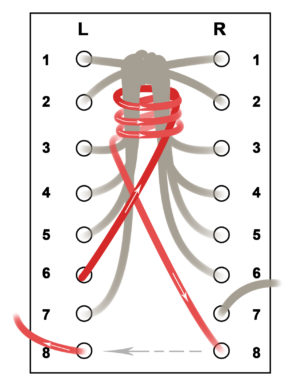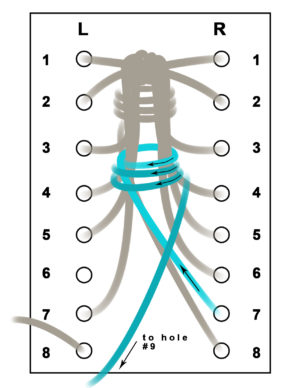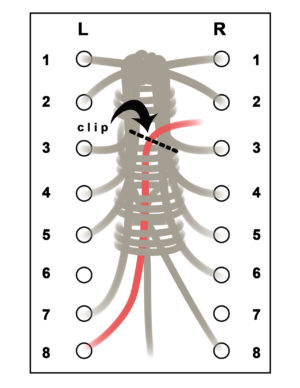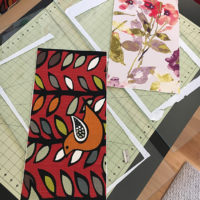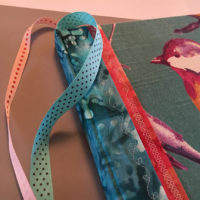Caterpillar Bookbinding Stitch Downloadable Sewing Instructions (click here to download these instructions)
Part 1 – the head of the caterpillar
Part 1 Step 1
- Using two curved needles and waxed thread, bring your thread up through the first two holes from the back. This could be one long thread or two different colors knotted together.
- Bring the thread (red thread a) from L1 down through R2.
- Bring that same thread back up through L2. Take that thread (orange thread b) up under the first thread (red thread a) and back down over it, into hole R4, skipping R3. Bring that same thread back up through L4.
NOTE: Check the back of the sewing constantly. Every thread should go straight across to its corresponding hole, creating a ladder effect with the threads. If you don’t see this then stop and step backwards until you find your mistake.
- Bring the thread coming out of R1 (yellow thread c) over all current threads and into L3. Bring that same thread back up through R3.
- Bring the thread from R3 (green thread d) under the threads coming out of R1 (yellow thread c) and R2 (red thread a) and then over those same threads and into L5. Bring that same thread back up through R5.
- Bring the thread from L4 (blue thread e) under just the first thread coming from L1 (red thread a) then over all the threads and into R6. Bring that same thread back up through L6.
Here’s another look at what each side of the thread is doing individually. You can’t sew them separately like this, of course, because each thread interacts with the other side – this just gives a clearer look at what each thread is doing.
Left Thread: Right Thread:
Part 1 Step 2
- Snug up the threads but don’t make them too tight. Bring the thread coming from R5 up, over and around all of the threads.
- Continue wrapping this bundle of threads until you get a ‘knob’ that resembles the head of an insect (3 to 5 wraps). This is called ‘packing.’
NOTE: The goal here is to wrap all of the threads and create a bundle that will become the head of the caterpillar. This is the only time the packing will run perpendicular to the caterpillar.
- On the last turn around the main group of threads bring the thread up behind all of the threads, as usual, and then down under just the first thread coming out of L1.
- Continue on to L7 then bring this thread back up through R7.
This is the end of Part 1 – creating the head. Part 2 will show you how to create the body of the caterpillar. This is a repeating step, so once you do it once, you’ll probably understand it well enough to do it over and over again without having to read the instructions.
Part 2 – the body of the caterpillar
- Bring the thread from L6 up and across all the threads on the right side and then under all threads between row 2 and row 3 on both the right and left sides. (Figure 1)
- Bring the threads over the vertical threads and back around and under all threads again. Continue wrapping (packing) the vertical threads until you have them as dense as you want them. You can make the body of the caterpillar as solid as you want. (Figure 2). Take that thread down into R8 and then back up through L8.
Figure 1
Figure 2
- Bring the thread coming out of R7 over all of the threads and then under the threads between the next section of holes – between holes 3 and 4. This time you will go under from left to right. Wrap (pack) this section as many times as you wish.
NOTE: When you are packing the body of the caterpillar you will always go under the threads starting on the opposite side of where your thread is coming out and you will end by going back into a hole, also on the opposite side of where you first came out. So, if it is coming out of a hole on the left side you will start the packing by going under the threads on the right side, and you will end by going into the next available hole on the right side.
Repeat this process until you have run out of holes for your caterpillar.
Part 3 – finishing it off
Now you have a couple of options of how to finish it off. The simplest thing to do is to stop after coming up through the last hole. Just run your needles, one at a time, up through the middle of the packed threads far enough to hide and secure both threads. Clip them so they don’t show. This method leaves lots of long legs behind, which might or might not be the look you want.
If you want fewer, shorter legs on the tail end then you can continue wrapping the sections without going back into any holes, until you have legs the length you want. Just alternate the threads, continuing down each section, and then finish off as described above.
